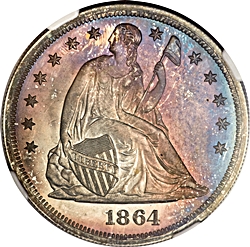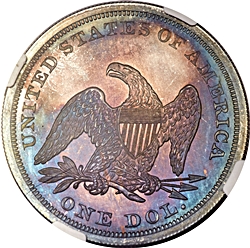 |
1864
 

|
 |
General Comments
|
| |||||||||||||||||||||
The finest known proofs are three PR68 coins graded by NGC. The highest proof graded by PCGS is a single PR67 example. NGC has graded two coins at this level. 14 coins have received a PR66 grade. One PCGS coin was evaluated as PR66+. 43 have been designated PR65. A total of 405 coins have been graded at all levels of proof by the two major services. This number places 1864 proofs in a consistent pattern with earlier dates after 1858. It also underscores the problem of re-submissions reported in the grading service population reports. We estimate that only a total of 300 1864 proofs survive. Population statistics are as of February, 2019.
1864 examples are usually well struck. Star centrals are usually sharply defined, and all other details above average. Reverses are almost always sharp, only occasionally displaying slight weakness on the upper left wing. High-grade business strikes are often prooflike or semi-prooflike, but frosty examples are equally available. In reviewing auction records we noted two different business strike examples in proof holders, one of them graded PR63.
1864 Die Marriages
5 die marriages have been positively identified. A single die pair was used to strike all business strikes. Neither die was used for proofs. Three different obverse dies were paired with two different reverses, both carried over from the 1863 proof production, to produce four proof die marriages. The following table summarizes the known die marriages:
Click the links below to view the details of each die marriage.
Die Marriage |
Rarity |
Obverse Die |
Reverse Die |
Estimated Survivors |
| OC-1 | R2 | 1 | A | 600 |
| OC-P1 | R4 | P1 | 1863 PA | 150 |
| OC-P2 | R4+ | P2 | 1863 PA | 110 |
| OC-P3 | R6- | P3 | 1863 PB | 25 |
| OC-P4 | R5- | P1 | 1863 PB | 65 |
We should note that a fourth obverse die was available for proof production. It was used to strike the with motto patterns (J-396, J-397, J-398, and J-399). To date we havenít confirmed the use of this die for regular issue 1864 proof production. The reverse die used for these patterns was our Reverse 1871 PA, indicating that they were probably struck in the 1870-1871 timeframe.
1864 Business Strike Emission Sequence
With only a single business strike die marriage the emission sequence is simple.
Emission Order |
Die Marriage |
Comments |
| 1 | OC-1 |
1864 Proof Emission Sequence
We believe that the extent of die polish on Obverse P1 and Reverses 1863 PA and 1863 PB indicates
that the sequence listed below is correct (with the exceptions noted). However, the differences are minute,
and open to interpretation. OC-P4 is a recently discovered die marriage. As a result it appears to be out
of order in the emission sequence.
Emission Order |
Die Marriage |
Comments |
| 1 | OC-P1 | |
| 2 | OC-P4 | Obverse P1 die polish slightly reduced the unfinished area under the chin |
| 3 | OC-P2 | Sequencing of OC-P2, OC-P3, and OC-P4 is partially subjective. We know that OC-P2 and OC-P4 came after OC-P1, and that OC-P3 came after OC-P4. Placement of OC-P2 and OC-P4 in positions 2 and 3 is arbitrary. The positions could be reversed. |
| 4 | OC-P3 |
1864 Quick Finder Chart
Attribution of 1864 die marriages is relatively easy. Neither the obverse nor reverse dies display major markers, but the obverse date positions are different enough to allow attribution of the obverse without worrying too much about the reverse. Only OC-P1 and OC-P4 share an obverse die. Minor reverse die markers allow easy identification of those two die marriages. The following table lists the keys for identifying each variety.
Die Marriage |
Obv Die |
Rev Die |
Right |
Keys |
| OC-1 | 1 | A | JL of C | Obverse: RB of 1 is JL of C. Very high date. Reverse: Vertical lines 1-1, 1-2, and 1-3 extend very faintly to horizontal line 2. |
| OC-P1 | P1 | 1863 PA | JL of RE | Obverse: Centered date slants S down. Base of 1 is JL of RE. 1 lines up 5-4.0. Reverse: No extensions of the vertical shield lines. The lowest horizontal shield line crosses the shield border, barely poking into the wing feathers. Dies usually but not always rotated 5-15 degrees counterclockwise. |
| OC-P2 | P2 | 1863 PA | L QTR | Obverse: Slightly high date slants down. Base of 1 is JL of RE. 1 lines up 5-1.5. Reverse: No extensions of the vertical shield lines. The lowest horizontal shield line crosses the shield border, barely poking into the wing feathers. |
| OC-P3 | P3 | 1863 PB | JL of C | Obverse: Low level date. Base of 1 is JL of C. 1 lines up 4-2.5. Reverse: Vertical shield line 1-3 extends to horizontal line 5. |
| OC-P4 | P1 | 1863 PB | JL of RE | Obverse: Centered date slants S down. Base of 1 is JL of RE. 1 lines up 5-4.0. Reverse: Vertical shield line 1-3 extends to horizontal line 5. |
| Photo credits:
Obverse and reverse full photos: 1864 NGC PR68, finest known, from the Heritage archives. |
